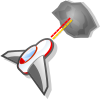- Free look
-

Part of a series on: Action video games Topics- List of beat 'em ups
- List of fighting game companies
- List of fighting games
- List of first-person shooters
- List of freeware first-person shooters
- List of third-person shooters
- List of light gun games
- List of maze video games
- List of platform games
Free look (also known as mouselook) describes the ability to move the mouse to rotate the player character's view in video games. It is almost always used for 3D game engines, and has been included on role-playing games, real-time strategy games, third-person shooters, first-person shooters, racing games, and flight simulators. Free look is nearly universal in modern games, but it was one of the significant technical breakthroughs of mid-1990s first-person perspective games.
3D games for console systems often have an analog stick dedicated to free look functionality.
History
An early primitive example was in Taito's 1992 first-person shooter arcade game Gun Buster, which featured a unique control scheme where the player moves using an eight-direction joystick and takes aim using a mounted positional light gun. The player could turn left or right by moving the gun pointer to the left or right edges of the screen.[1][2] However, the game lacked the ability to look up or down.
Fully 3D first-person games with free look had appeared as early as 1992 on the PC, although vision was controlled by dedicated keys rather than the mouse. At the time it was still cutting-edge technology and didn't become widespread until the age of 3D accelerators. For instance, in the 1993 seminal game Doom, it was not possible for the player to angle his or her view up or down. Dark Forces released in 1995 and more technologically advanced, featured 3D look but more restricted than the free look of the earlier Ultima Underworld and System Shock, released in 1992 and early 1994 respectively.
Raven Software's November 1994 release CyClones featured a rather primitive implementation of the free look; main movement was via keyboard (with turning and strafing via key combinations), but the on-screen weapon aim point was moved independently via the mouse. Moving the aim point against the edge of the screen would cause the viewpoint to shift up (only temporarily) or to the side (again, haltingly). Unfortunately, this system proved cumbersome and Raven Software did not develop this particular system further. The 1993 MS DOS version of Bram Stoker's Dracula also used the mouse to aim the player's weapon cross-hair, similar to CyClones, but the player's viewpoint was controlled entirely by the keyboard and did not move with the cross-hair.
The next major step was using the mouse to control the free look. Marathon by Bungie, released in December 1994 for the Apple Macintosh was the first major release to feature the mouse-controlled free look that would later become universal. The first major game for Intel-based PCs to use full-time fully 3D mouselook was Terminator: Future Shock (published by Bethesda Softworks in 1995).[3] However, Terminator: Future Shock did not become very popular and the original Marathon was not available on the PC platform, so their impact was limited. Quake (1996), is widely considered to have been the turning point in making free look the standard, in part due to its Internet multiplayer feature, which allowed large numbers of mouse and keyboard players to face each other head-to-head. Although games using older engines continued to appear for a few years, the 3D accelerator boom in the mid-90's meant that for the first time true 3D engines could be run on home PCs, and free mouse look would rapidly become essential and standard in almost every 3D game.
References
- ^ Gun Buster at the Killer List of Videogames
- ^ Gunbuster - Arcade, Games Database
- ^ http://www.gamefaqs.com/computer/doswin/review/R117939.html
Categories:- Video game control methods
- Virtual reality
Wikimedia Foundation. 2010.
